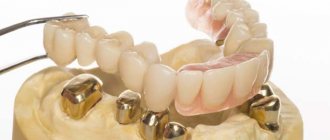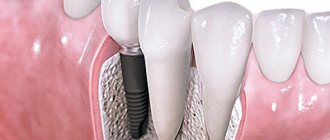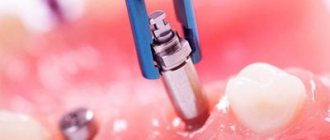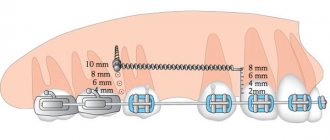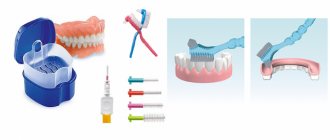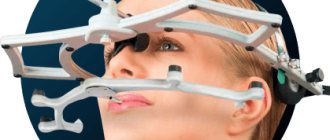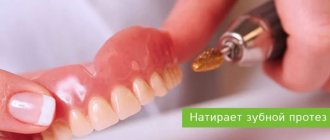Most modern people fail to maintain a full set of teeth by midlife. A couple of decades ago, a way out of such a situation could have been prosthetics in the form of installing a bridge or using removable dentures. Today, the fantastic dream of many generations has come true - it has become possible to install implants (or “artificial teeth”) that are superior to natural ones in their strength and aesthetics. Why so many patients fell in love with mini implants, and whether they are so reliable and durable, we will analyze further.
Principle of technology
Small implants, smaller models of classic ones, are used as support for a complete removable denture. Their diameter is only 1.8-2.4 mm, and their length is 6-10 mm. They are installed in an atraumatic way - by puncturing the gums, without extensive incisions. Removable prosthetics on mini-implants are carried out even in conditions of jaw bone atrophy - the height and density of bone tissue does not matter, there is no need to build it up.
Immediately on the day of implantation, a removable prosthesis is fixed onto the heads of the implants protruding above the gum , which combines the implants into one system . On the inner surface of each implant there are recesses with metal holders and silicone rings (support points). The fastening mechanism holds the structure and evenly distributes the load between the implants and the prosthesis itself. As a result, the bone tissue is “in working condition,” which stops bone atrophy (loss).
Prosthesis on mini-implants
Installation of a removable denture supported by mini-implants is an express procedure. Installation of implants takes up to 30 minutes depending on their number - 5 minutes for each. Digital impressions are immediately taken and sent to the laboratory. After 2-3 hours, the finished prosthesis is fixed.
Price
The low price of mini-implants is often the main reason for their installation. The cost of micro-structures is several times less than the price of conventional implants.
For example, if the price of a standard implant averages 25,000 rubles, then the cost of mini-structures is usually 40-50% lower. This is due to the fact that the operation of installing implants occurs in a short period of time, it does not require complex equipment, and a minimum of materials is used for the manufacture of the structures themselves.
The low price of the pins attracts a lot of patients to them. It allows you to install more implants for a small fee. The savings are especially noticeable when installing multiple dental structures for patients.
The cost of one mini-implant averages about 20,000 rubles. The operation to install micro-implants costs about 10-16,000 rubles. Implantation using the MIS system costs 28,000 rubles, and for the All-on-4 operation the patient will have to pay around 120,000 rubles.
Advantages of prosthetics with mini-implants
Dentures on mini-implants are a low-traumatic, fast and affordable way to restore dentition without additional surgeries and expenses.
- Minimally invasive implantation Miniature implants are installed without incisions in the gums - through a puncture of the mucous tissue.
- No additional operations No need for bone grafting - mini-implants are fixed even with critical bone deficiency.
- Result in one day Dentures are installed immediately on the day of implantation - they are made in the laboratory in 2-3 hours.
- Accelerated rehabilitation Low-traumatic implantation protocol allows you to avoid swelling and pain - recovery in 3 days.
- Ease of use Dentures on mini-implants are less bulky than traditional ones, do not fall out while eating, and do not injure the gums.
- Affordable cost The most budget-friendly option for prosthetics due to the low cost of mini-implants and the lightweight design of the prosthesis.
Prosthetics on mini-implants allows you to reduce the disadvantages of traditional dentures.
Supports in the form of mini-implants improve comfort during use - they allow you to achieve stability and reduce the base of a removable denture, but cannot withstand full loads, like classic implant models.
Levin Dmitry Valerievich Chief physician and founder of the Doctor Levin center
Orthoimplants in dentistry: why are they needed, what functions do they perform and is it painful to place them?
Article navigation
- Key characteristics and features
- Advantages
- Flaws
- When are orthodontic implants installed?
- In what cases is installation contraindicated?
- Stages of implantation of structures
- Potential risks and possible complications
- Oral care after orthoimplants
- Popular questions and answers on the topic
question to a specialist
Complex cases associated with anomalies in the structure of the dentofacial apparatus sometimes require radical measures. In such situations, it is not enough to install a braces system; you need to prepare your teeth for the upcoming changes, and for this you often have to resort to removing one or several molars at once. This is usually done if there is not enough free space to change the position of the remaining teeth. Sometimes this process can be avoided by installing special orthodontic implants. These are small structures that are fixed during treatment and provide the necessary support for a fixed orthodontic system. Further in this article we will understand what it is, in what cases special implants are used and what characteristics they have.
Application area
- Removable prosthetics The main purpose of mini-implants is to support a removable denture with complete edentia, which improves comfort during its use. The prosthesis is fixed, does not move, no gels are needed for fixation. The structure is reinforced with a metal frame for uniform load distribution and strength, which increases service life. But it cannot withstand strong pressure due to the small size of the supports.
- Temporary prosthetics With classical implantation, especially combined with bone grafting, the implants cannot be loaded immediately; time is required for their healing. In this case, a temporary lightweight prosthesis is attached to mini-implants, which are installed between regular ones. A person can eat normally and not feel aesthetic discomfort. After engraftment of the classic, mini-implants, they are removed and the permanent prosthesis is fixed.
Oral care after orthoimplants
After the implantation of mini-implants, there are no additional requirements for oral care. Such structures are fixed as part of orthodontic treatment, which involves the presence of a permanent brace system in the patient’s mouth. Accordingly, it is necessary to ensure the proper level of hygiene, and for this you will have to devote twice as much time to caring for teeth, plates and implants.
The basic principles include brushing your teeth twice daily, using special orthodontic brushes and brushes, regularly rinsing your mouth after meals, and using an irrigator. The latter is a small device that supplies a fairly powerful flow of water and air for high-quality cleaning of hard-to-reach places. You will also have to avoid products that are too hard and stretchy, which can damage system parts. If you suddenly discover that the implant is damaged, you need to see a doctor immediately.
Modern orthoimplants can be installed in patients of almost any age category – adolescents and adults. With the advent of such temporary structures, we have an excellent opportunity not only to speed up the process of correcting the bite, but also to refuse to remove healthy teeth.
Dental implantation using the Osstem system = 18,500 rubles. until January 15, 2022!
All inclusive, treatment guaranteed!
Premium implants at an affordable price. Free consultation with an implantologist +7 (495) 215-52-31 or write to us
How many implants are needed if there are no teeth?
To create a stable support for a removable denture with complete edentia, it is recommended to install:
- on the lower jaw - 4 mini-implants
- on the upper jaw - 6 mini-implants
The difference in quantity is due to the physiologically lower density of the maxillary bone.
Installing a smaller quantity will lead to improper load distribution and failure of the structure.
In order to reduce the cost of treatment, some clinics also install two mini-implants under a full-fledged prosthesis. They are installed in the anterior section, and the chewing areas remain without any fixation. But this is not the best option. When chewing, the denture will move and create a lever effect on the implants. It is easy to guess that the structure will fail very quickly. The initial savings will result in even greater costs in the future.
Chashchin Kirill Valerievich
Orthopedic dentist, 14 years of experience
Virtuoso of prosthetics on implants. Competent planning and diagnostics, creation of comfortable prostheses taking into account individual parameters.
More about the doctor
Possibility of use
Mini implants are used by orthodontists in the following clinical situations:
- in preparation for prosthetics: to prevent displacement of existing teeth if replacement of missing teeth cannot be done immediately;
- to correct the bite (in combination with braces): they correct the position of the teeth, fix them in the desired position and speed up the treatment process;
- for reliable fastening of removable orthodontic appliances (due to their excellent stabilization in the jaw) immediately after the operation of implanting pins.
Stages of installing dentures on mini-implants
Preliminary diagnostic and preparatory measures are carried out - this stage determines the success of the entire treatment. In our Center, the treatment plan is drawn up by an orthopedist after analyzing a computer examination and a functional study of the bite. It is the orthopedist who calculates the required number of implants and fixation points on the jaw to evenly distribute the load and ensure proper closure of the teeth after prosthetics.
The prosthetic process itself takes place in one visit; you will receive new teeth in 3-4 hours without leaving the walls of the Center .
- Mini-implantation It is carried out in a minimally invasive way. Punctures are made in the gums, miniature holes are formed in the bone, into which the implants are screwed. It takes only 5 minutes to install one implant
- Prosthetics Using an intraoral scanner, digital impressions are taken and sent to the laboratory electronically. Production in our Center is automated. After 2-3 hours, the finished prosthesis is attached to mini-implants
Mini-implantation is a gentle, low-traumatic technology; local anesthesia is usually sufficient. For anxious patients, we offer implantation in medicated sleep - without fears or nervous shock.
Rehabilitation period
Mini-implantation is a minimally invasive procedure, so recovery is easy and without much discomfort. After a week, all the unpleasant sensations go away. In case of individual predisposition, slight swelling is possible. For such a case, our Center provides a complex of accelerated rehabilitation. Prevents facial swelling and relieves pain.
Getting used to dentures with mini-implants is much easier and faster than with conventional removable ones - adaptation takes only 2-3 days due to the reduced size of the base.
Life time
With proper care, the removable structure on mini-implants lasts about 5-7 years . Miniature supports are not able to withstand heavy loads for long, so they gradually become loose.
As a quick way to restore teeth on a limited budget, this is a good option. But if you think about the longer-term result, it is better to use standard implants for supports with a lifetime guarantee. The risks of bone tissue atrophy around even four mini-supports are always higher than when using two or three classic implants.
Contraindications
Microimplants are less traumatic than conventional implants, but their installation has a number of contraindications. Most of them are not absolute. A final decision on the possibility of installing a microimplant will require examination and, possibly, additional treatment. Contraindications include:
- Diabetes mellitus in the stage of decompensation.
- Inflammation in the oral cavity.
- Gum diseases.
- Loose bone tissue.
- Mental illnesses.
- Oncological diseases.
Microimplants should not be placed on patients who smoke. Smoking slows down the healing process, which can cause various complications and reduce the effectiveness of orthodontic treatment. Therefore, patients who are not ready to give up the habit will have to use alternative options.
Alternatives and comparison of implant prostheses
If you choose from the possible options for removable prosthetics, prostheses on mini-implants are a middle option between traditional prostheses and those fixed to classic implants
| Regular removable | On classic implants | On mini-implants |
| Dimensions are bulky | Reduced sizes | Reduced sizes |
| Getting used to it up to a month | Getting used to it 2-3 days | Getting used to it 2-3 days |
| Reliability of fixation fall out, shift | Reliability of fixation securely fixed | Reliability of fixation deteriorates over time |
| Effects on gums: soreness, inflammation | Impact on gums is minimal | The impact on the gums is minor |
| The risk of bone atrophy is high | The risk of bone atrophy is moderate | Above average risk of bone atrophy |
| Strict dietary restrictions | Minimal dietary restrictions | Average dietary restrictions |
| Requires removal for maintenance after every meal | Need to remove for maintenance 1-2 times a month to clean the fasteners | Need to remove for maintenance once every 2-3 days to clean the fasteners |
| Service life up to 5 years | Service life from 10 years | Service life 5-7 years |
As can be seen from the table, removable dentures with classic implants are advantageous, but also have disadvantages. The only effective and long-term alternative is a fixed full denture with 6 traditional implants or a segmented denture with 8 implants. Such dentures consist only of a series of dental crowns without artificial gums and look as natural as possible. They do not need to be removed for maintenance. And most importantly, they completely stop bone tissue atrophy and even promote its restoration.
Free consultation
Our specialists will conduct a free consultation and select the best treatment option for you.
Sign up now! Online registration
+7 (495) 649-41-19
Installation on ball adapters
This is a classic fastening option that has been successfully used for about 10 years. Such adapters are made of metal material and resemble small balls protruding beyond the mucous membrane.
It should be noted that a recess is created on the inside of the prosthetic device, which is necessary for fixing the holder and the silicone matrix. When fixing this design, the matrix helps to securely hold the ball-shaped adapter in the neck area.
Specifics of installation using the LOCATOR system
This is one of the most modern methods of fixing removable orthopedic structures. It is characterized by increased comfort for the patient. In this case, transition elements of the equatorial type are used, which have a specific shape. The diameter of such implants can reach 2.5-4.0 mm.
Also, the advantages of the LOCATOR system include: ease of fixation and removal of the prosthesis, no need for frequent visits to a specialist, and the possibility of use when the axes of dental structures do not correspond to each other. Moreover, in the case of using equator-type adapters, the likelihood of their wear and the need for replacement is eliminated.
